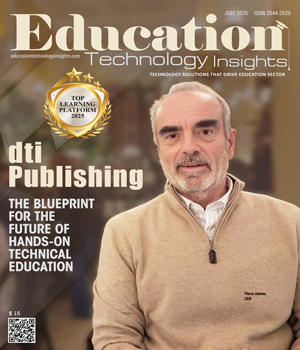THANK YOU FOR SUBSCRIBING
Be first to read the latest tech news, Industry Leader's Insights, and CIO interviews of medium and large enterprises exclusively from Education Technology Insights
Overcoming Challenges in EdTech: Navigating the Path to Effective Educational Technology
Luis Bernardo Olarte, Director of Technology and Information Systems. Colegio Nueva Granada (CNG)
 Luis Bernardo Olarte, Director of Technology and Information Systems. Colegio Nueva Granada (CNG)
Luis Bernardo Olarte, Director of Technology and Information Systems. Colegio Nueva Granada (CNG)Educational technology, commonly known as EdTech, has become a game-changer in education, transforming how we teach and learn. However, like any other innovation, EdTech also faces challenges that must be addressed for its effective integration in educational settings. As schools and institutions continue to leverage technology to enhance the learning experience, it is crucial to identify and overcome these challenges to ensure that EdTech can truly deliver its potential benefits.
In the first place, a big challenge we need to accept new technologies and evolve rapidly. Educational institutions just surpassed the difficulties imposed by the pandemic, like switching to hybrid learning models, with all its implications regarding adopting new technologies, intensive user use of online platforms, social-emotional support, increased screen time, and so on. With the emergence of cutting-edge technologies such as ChatGPT, its essential to continue evolving and incorporate the “good use” of AI platforms in the curriculums and consider the best approaches to measure students’ performance even if they are using artificial intelligence tools.
As a success case, we combine three different technologies at CNG: Face recognition with AI, IOT with Vaping detectors, and Analytics. This is to detect and support students at risk of using e-cigarettes.
In the second place, developing robust Professional Development Programs for Teachers is essential. Technology continually evolves, and teachers must constantly update their skills and knowledge to integrate EdTech effectively into their instructional practices. However, many teachers may need more training and support to use EdTech tools and strategies effectively. To overcome this challenge, it is crucial to invest in comprehensive professional development programs that provide ongoing training, resources, and support for teachers. This can include workshops, seminars, online courses, and recognition programs to engage and help teachers effectively develop the skills and confidence to use EdTech in their classrooms.
Supporting your EdTech integration process with proven models like SAMR, TPACK, or ISTE Standards is helpful. Using these models encourages educators to use technology in ways that would not be feasible without it, rather than just replacing traditional teaching techniques with it (by utilizing digital versions of paper worksheets, for example). It also helps ensure that technology is used effectively and positively impacts student learning outcomes.
Another crucial aspect nowadays is related to Privacy and Security. As technology becomes more prevalent in education, there are growing concerns about data privacy and security. EdTech platforms often collect and store student data, which raises concerns about privacy, confidentiality, and data security.
Educational institutions need robust data protection policies to ensure student data is kept secure and used responsibly. It is essential to carefully select EdTech tools that comply with privacy regulations, provide transparent data collection practices, and prioritize the security of student information.
“To guarantee that technology is used to promote the best learning outcomes for all students, collaboration between educators, students, parents, and stakeholders is ultimately necessary for the success of the EdTech strategy.”
Specialized security firms found a 230% rise in ransomware attacks against the education sector in 2022 compared to 2021. One of the main concerns among CIOS is Ransomware as a Service, in which any individual can pay for a platform to launch Ransomware attacks. In case of success, attackers can ask for an amount of money that is an average of USD 500.000 (but also depends on the victim's size), and even worst, the standard of victims who pays to rescue their information is above 80 percent.
Another critical aspect is establishing a robust program to promote and educate your institution's community on security awareness. Students and parents must understand how to navigate the numerous platforms and the risks that come with them.
At CNG School, we developed a comprehensive Cybersecurity program based on the NIST Cybersecurity Framework program. An essential part of the program is to support staff to be better prepared in case they need to face situations of a phishing attack or ransomware attack, among others. We perform periodic simulations and training courses for those failing the simulation tests.
Also, on the list is Equity and Inclusivity. EdTech should be developed and implemented to support fairness and diversity in education. Ensuring EdTech tools and materials are accessible to students with different requirements, such as those who are English language learners, have impairments, or come from different cultural backgrounds, is crucial for their success.
And, last but not least are Cost and Sustainability. Educational institutions may need help with implementing EdTech initiatives. Infrastructure, software licenses, and other technological resources can be expensive to buy and maintain. Furthermore, technological development may make some tools obsolete, necessitating regular upgrades or replacements. To ensure that EdTech initiatives can be adopted and sustained over the long term, educational institutions must carefully evaluate such programs' cost-effectiveness and sustainability. This difficulty can be overcome by working with stakeholders, requesting outside financing, and investigating affordable options. It is also important to evaluate different options for acquiring technology, such as direct purchase, leasing, and technology as a service. Considering these alternatives using different perspectives, including School’s financial situation, technology obsolescence, and the device's lifetime, is crucial. That way, it is possible to establish an investment plan that must be renewed every three years at least.
In conclusion, EdTech has had a tremendous impact on education recently. Addressing these issues will enable educational institutions to use EdTech's potential to improve the educational process and prepare students for the digital era. The goal is to ensure that EdTech initiatives are created and carried out in a way that assists teachers in gaining the knowledge and confidence necessary to use EdTech successfully in their classrooms. To guarantee that technology is used to promote the best learning outcomes for all students, collaboration between educators, students, parents, and stakeholders is ultimately necessary for the success of the EdTech strategy.
Read Also
Elevating Engaged Teaching in a Digital Era
Embedding Immersive Technologies within the Curriculum: Strategies for Sustainable Development
Aligning Innovation with Impact in Higher Education
Advancing Digital Teaching and Lifelong Learning
How to Craft Europe's Next Chapter Through Digital Unity
Teaching in a Time of Transition

I agree We use cookies on this website to enhance your user experience. By clicking any link on this page you are giving your consent for us to set cookies. More info























